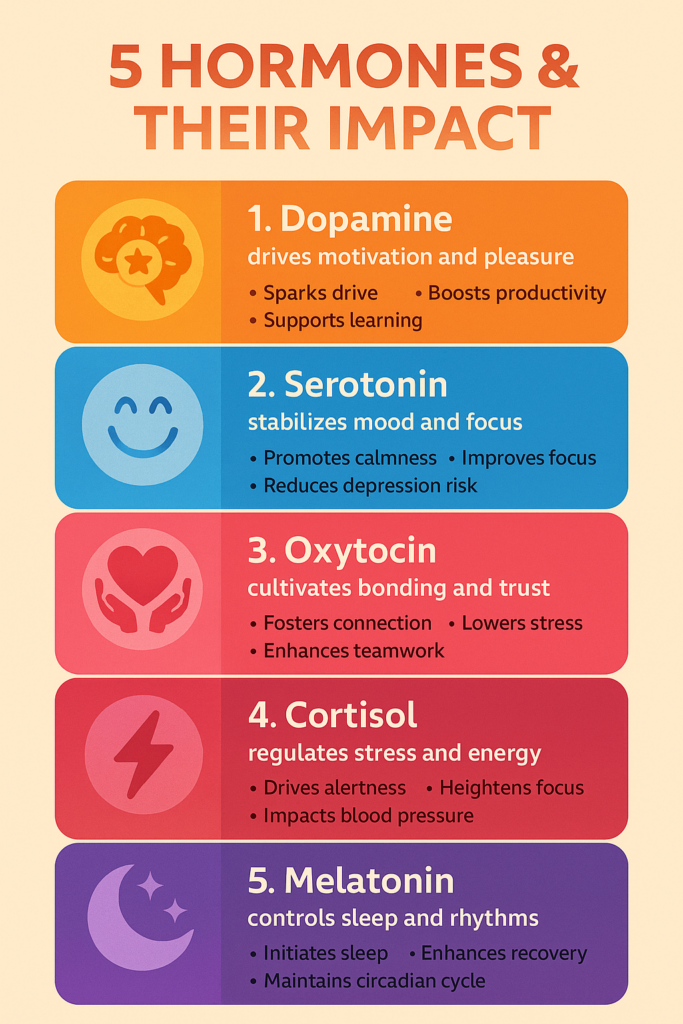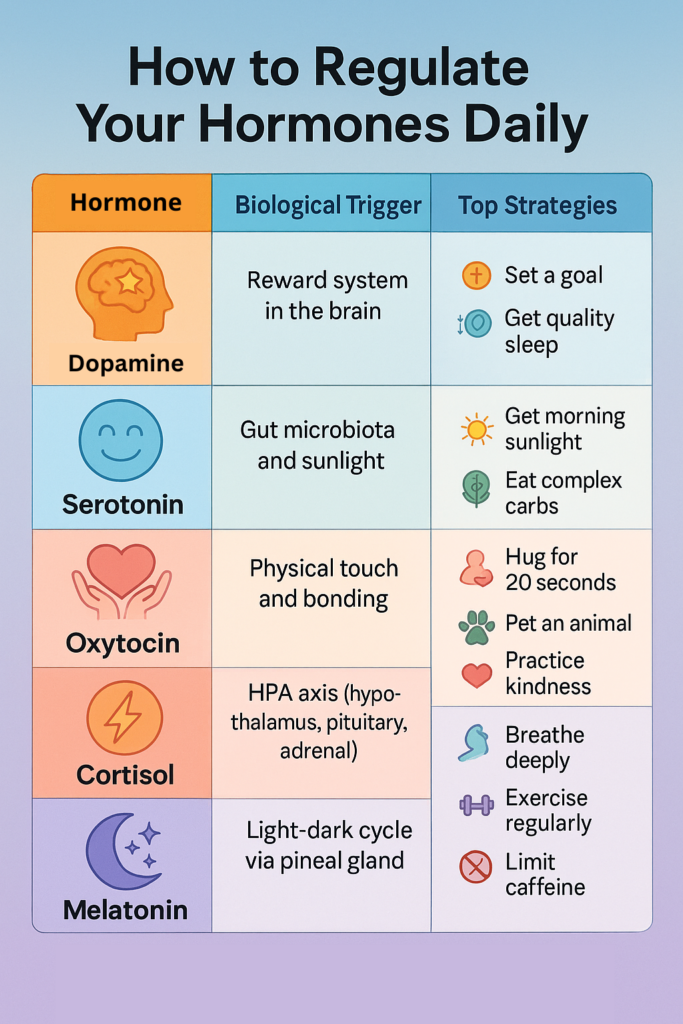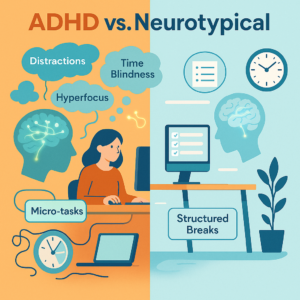Hormones act as the body’s chemical messengers, regulating mood, energy levels, sleep patterns, and stress responses. Among them, five stand out for their significant influence on our daily lives, productivity, and overall well-being: dopamine, serotonin, oxytocin, cortisol, and melatonin. This article delves into the roles of these key hormones, their effects, and evidence-based strategies for managing them, presented with a concise, point-by-point summary and backed by scientific sources.

Dopamine: Boosting Motivation and Reward
What is it? Dopamine is a neurotransmitter produced in the brain’s substantia nigra and ventral tegmental area, playing a central role in the brain’s reward system. It communicates feelings of pleasure and motivation, encouraging behaviors that lead to rewarding outcomes such as eating, socializing, or achieving goals. However, when dopamine signaling becomes dysregulated—often due to overstimulation—it can lead to receptor desensitization, which is associated with problems like addiction and reduced motivation.
Why it’s specific: Dopamine is primarily produced and released through the brain’s mesolimbic pathway, which is activated by rewarding experiences such as novelty, accomplishment, or sensory enjoyment. Unlike many other hormones, dopamine operates through rapid feedback mechanisms—its release is triggered almost instantly by activities like task completion or new experiences, engaging D1 and D2 receptors. However, excessive stimulation from artificial sources like social media or sugary foods can lead to receptor downregulation, diminishing dopamine sensitivity. As a result, effective regulation strategies emphasize natural, sustainable sources of stimulation. On a biological level, dopamine synthesis depends on the amino acid tyrosine, which is converted by enzymes such as tyrosine hydroxylase, allowing for targeted dietary and behavioural approaches to support healthy dopamine levels.
- Set small, achievable goals: Break tasks into manageable steps (e.g., write 100 words) to trigger dopamine release upon completion, reinforcing motivation.
- Engage in novel activities: Try a new hobby like painting to stimulate dopamine through activation of the brain’s curiosity circuits.
- Limit digital overstimulation: Cap social media or gaming at 30 minutes daily to prevent dopamine receptor desensitization.
- Eat tyrosine-rich foods: Include eggs, chicken, or bananas, as tyrosine is a direct precursor to dopamine synthesis.
- Exercise with variety: Alternate HIIT, cycling, or yoga to boost dopamine through physical reward and novelty.
Serotonin: Stabilizing Mood and Well-Being
What is it? Serotonin is both a neurotransmitter and a hormone, primarily produced in the gut by enterochromaffin cells and in the brain by the raphe nuclei. It plays a key role in regulating mood, sleep, and appetite, contributing to emotional balance through its interaction with 5-HT receptors. Approximately 90% of serotonin is produced in the gut, making its levels highly sensitive to diet and the health of the gut microbiome. Imbalances in serotonin are commonly associated with mood disorders such as depression and anxiety.
Why it’s specific: Serotonin stands out due to its dual sites of production—the gut and the brain—which make it uniquely responsive to both nutritional and environmental factors. Dietary intake of tryptophan, a precursor amino acid, and the state of the gut microbiome significantly influence serotonin levels. Sunlight exposure also boosts serotonin production by activating retinal pathways that stimulate the raphe nuclei. In contrast to dopamine’s rapid reward-driven spikes, serotonin contributes to a more stable emotional baseline. Practices like gratitude and mindfulness can increase serotonin by activating prefrontal cortex circuits. Its synthesis depends on the enzyme tryptophan hydroxylase, which is influenced by factors like vitamin D and gut flora, enabling targeted interventions through sunlight, probiotics, and nutrition.
- Get morning sunlight: Spend 10–15 minutes outside to boost serotonin via retinal-brain signaling.
- Eat tryptophan-rich foods: Include turkey, salmon, or oats, as tryptophan is converted to serotonin.
- Practice gratitude or mindfulness: Write three things you’re grateful for daily to enhance serotonin through positive emotional circuits.
- Support gut health: Eat probiotic-rich yogurt or kefir to optimize gut serotonin production.
- Socialize meaningfully: Spend time with friends to elevate serotonin through social bonding.
Oxytocin: Enhancing Connection and Trust
What is it? Oxytocin is a peptide hormone and neuropeptide produced in the hypothalamus and released by the pituitary gland, often referred to as the “love hormone.” It plays a central role in promoting social bonding, trust, and emotional connection, while also helping to reduce stress. Oxytocin levels rise during moments of physical touch, childbirth, or close emotional interaction, acting on receptors throughout the brain and body—particularly within the amygdala—to reduce fear and enhance feelings of safety.
Why it’s specific: Oxytocin is uniquely released in response to both physical and emotional closeness, with sensory inputs such as touch, eye contact, or vocal tone activating neurons in the hypothalamus. Unlike cortisol, which surges during stress, oxytocin plays a calming, protective role by suppressing the activity of the hypothalamic-pituitary-adrenal (HPA) axis, making it essential for feelings of social safety and emotional resilience. Its receptors are concentrated in brain regions like the amygdala and prefrontal cortex, which govern emotion and social behavior—making actions like hugging, kind gestures, or shared experiences powerful triggers for its release. Due to its short half-life, oxytocin’s effects are brief, requiring consistent, meaningful interactions to maintain its benefits and enabling precise behavioral strategies for emotional health.
- Incorporate physical touch: Hug or cuddle for 20 seconds daily to trigger oxytocin release via skin sensory neurons.
- Spend quality time: Share uninterrupted conversations to foster trust and oxytocin production.
- Pet an animal: Stroke a pet for 5–10 minutes to boost oxytocin for both you and the animal.
- Practice acts of kindness: Compliment or help someone to stimulate oxytocin through social connection.
- Try partner-based activities: Dance or team sports enhance oxytocin via synchronized movement.
Cortisol: Managing Stress and Energy
What is it? Cortisol is a glucocorticoid hormone released by the adrenal glands and regulated by the hypothalamic-pituitary-adrenal (HPA) axis. Often referred to as the body’s primary stress hormone, it plays a key role in mobilizing energy by raising blood sugar levels and enhancing alertness. Cortisol follows a natural daily cycle, peaking in the morning to promote wakefulness and gradually declining by evening. However, chronic stress can disrupt this rhythm, leading to persistently elevated levels that may contribute to fatigue, weight gain, and weakened immune function.
Why it’s specific: Cortisol regulation is controlled by the HPA axis, which responds to both physical and psychological stressors as well as circadian signals from the suprachiasmatic nucleus. Unlike oxytocin, which is triggered by social interactions, cortisol levels rise in response to perceived threats. This increase is driven by adrenocorticotropic hormone (ACTH) signaling to the adrenal glands. Cortisol is particularly sensitive to factors like caffeine, sleep disturbances, and chronic stress, which makes strategies such as maintaining consistent routines or practicing relaxation techniques highly effective. On a biological level, cortisol’s feedback loop is influenced by glucocorticoid receptors, meaning that calming the nervous system can help reduce its overproduction, allowing for targeted approaches to managing stress.
- Follow a consistent sleep schedule: Sleep and wake at the same time (e.g., 10 PM–6 AM) to align cortisol’s circadian rhythm.
- Practice deep breathing: Use the 4-7-8 technique for 2–3 minutes to lower cortisol by activating the parasympathetic nervous system.
- Limit caffeine after noon: Switch to herbal tea to avoid cortisol spikes that disrupt evening relaxation.
- Engage in low-stress exercise: Walk or do gentle yoga to avoid overexertion-driven cortisol increases.
- Schedule downtime: Spend 15–30 minutes on calming activities like reading to signal safety and reduce cortisol.
Melatonin: Optimizing Sleep and Recovery
What is it? Melatonin is a hormone produced by the pineal gland that regulates the sleep-wake cycle by signalling the body to rest in response to darkness. Its production is inhibited by light, particularly blue wavelengths, which affect the retinal signals sent to the suprachiasmatic nucleus, the brain’s circadian clock. Melatonin plays a crucial role in supporting recovery, mood, and immune function, with disruptions often linked to conditions like insomnia and fatigue.
Why it’s specific: Melatonin’s production is uniquely governed by the pineal gland’s sensitivity to the natural light-dark cycle, which is regulated by the suprachiasmatic nucleus. Exposure to blue light, such as from screens, inhibits melatonin synthesis by blocking the activation of retinal melanopsin, making light management essential for maintaining healthy sleep patterns. Unlike cortisol, which fluctuates with stress, melatonin steadily increases in response to darkness, requiring consistent environmental cues for optimal production. Strategies like using dim lighting in the evening or establishing regular sleep routines can directly support melatonin pathways. Additionally, melatonin’s precursor, serotonin, is converted into melatonin by enzymes like N-acetyltransferase, which are sensitive to circadian rhythms, allowing for targeted interventions aligned with the body’s natural cycles.
- Dim lights in the evening: Use amber lighting after 8 PM to mimic darkness and signal melatonin production.
- Avoid screens before bed: Limit devices 1–2 hours before sleep or use blue-light-blocking glasses to prevent melatonin suppression.
- Create a bedtime ritual: Follow a routine (e.g., tea, reading at 9:30 PM) to cue melatonin release.
- Eat melatonin-supporting foods: Snack on cherries or walnuts, which contain melatonin or its precursors.
- Keep your bedroom cool and dark: Set 60–67°F (15–19°C) and use blackout curtains to enhance melatonin during sleep.

Balancing Hormones for a Better Life
The interplay of these hormones shapes daily experiences. Imbalances disrupt productivity and health, but targeted strategies help:
- Exercise boosts dopamine, serotonin, and oxytocin while lowering cortisol.
- Diet supports serotonin and dopamine with precursors like tryptophan and tyrosine.
- Sleep optimizes melatonin and cortisol rhythms.
- Connections elevate oxytocin and serotonin.
- Stress management reduces cortisol, supporting all hormones.
References
- Young, S. N. (2007). How to increase serotonin in the human brain without drugs. Journal of Psychiatry & Neuroscience, 32(6), 394–399.
- Discusses serotonin’s role in mood and non-pharmacological strategies like sunlight and diet.
- Beaulieu, J., & Burnstein, R. (2019). Dopamine: Functions, signaling, and association with neurological diseases. Cellular and Molecular Neurobiology, 39(1), 31–45.
- Covers dopamine’s reward system and dietary influences like tyrosine.
- Uvnäs-Moberg, K., & Petersson, M. (2005). Oxytocin, a mediator of anti-stress, well-being, social interaction, growth and healing. Zeitschrift für Psychosomatische Medizin und Psychotherapie, 51(1), 57–80.
- Explains oxytocin’s role in bonding and stress reduction via touch.


